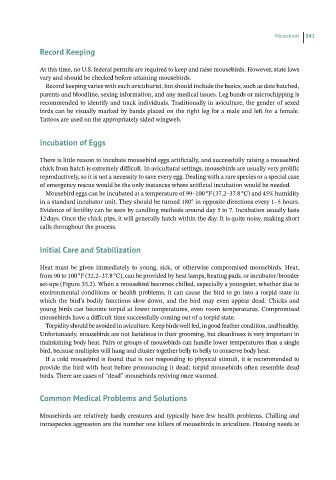Page 542 - Hand rearing birds second
P. 542
Mousebirds 541
RecordKeeping
At this time, no U.S. federal permits are required to keep and raise mousebirds. However, state laws
vary and should be checked before attaining mousebirds.
Record keeping varies with each aviculturist, but should include the basics, such as date hatched,
parents and bloodline, sexing information, and any medical issues. Leg bands or microchipping is
recommended to identify and track individuals. Traditionally in aviculture, the gender of sexed
birds can be visually marked by bands placed on the right leg for a male and left for a female.
Tattoos are used on the appropriately sided wingweb.
Incubationof Eggs
There is little reason to incubate mousebird eggs artificially, and successfully raising a mousebird
chick from hatch is extremely difficult. In avicultural settings, mousebirds are usually very prolific
reproductively, so it is not a necessity to save every egg. Dealing with a rare species or a special case
of emergency rescue would be the only instances where artificial incubation would be needed.
Mousebird eggs can be incubated at a temperature of 99–100 °F (37.2–37.8 °C) and 45% humidity
in a standard incubator unit. They should be turned 180° in opposite directions every 1–5 hours.
Evidence of fertility can be seen by candling methods around day 5 to 7. Incubation usually lasts
12 days. Once the chick pips, it will generally hatch within the day. It is quite noisy, making short
calls throughout the process.
InitialCareand Stabilization
Heat must be given immediately to young, sick, or otherwise compromised mousebirds. Heat,
from 90 to 100 °F (32.2–37.8 °C), can be provided by heat lamps, heating pads, or incubator/brooder
set-ups (Figure 35.2). When a mousebird becomes chilled, especially a youngster, whether due to
environmental conditions or health problems, it can cause the bird to go into a torpid state in
which the bird’s bodily functions slow down, and the bird may even appear dead. Chicks and
young birds can become torpid at lower temperatures, even room temperatures. Compromised
mousebirds have a difficult time successfully coming out of a torpid state.
Torpidity should be avoided in aviculture. Keep birds well fed, in good feather condition, and healthy.
Unfortunately, mousebirds are not fastidious in their grooming, but cleanliness is very important in
maintaining body heat. Pairs or groups of mousebirds can handle lower temperatures than a single
bird, because multiples will hang and cluster together belly to belly to conserve body heat.
If a cold mousebird is found that is not responding to physical stimuli, it is recommended to
provide the bird with heat before pronouncing it dead; torpid mousebirds often resemble dead
birds. There are cases of “dead” mousebirds reviving once warmed.
CommonMedicalProblemsand Solutions
Mousebirds are relatively hardy creatures and typically have few health problems. Chilling and
intraspecies aggression are the number one killers of mousebirds in aviculture. Housing needs to

